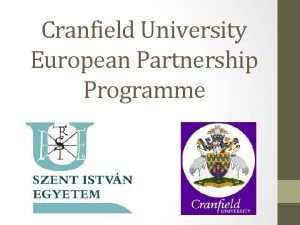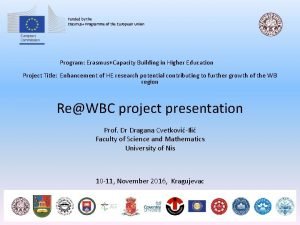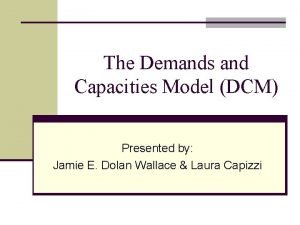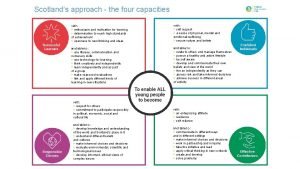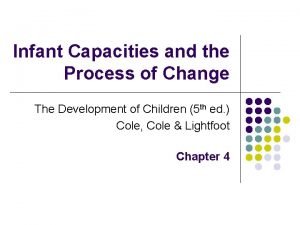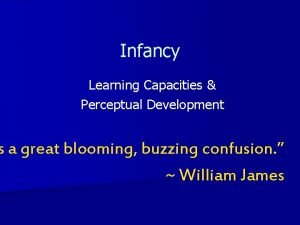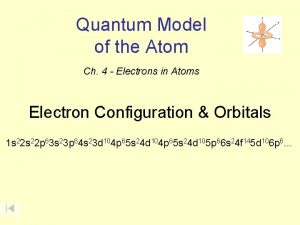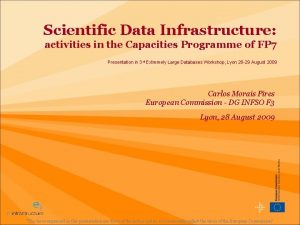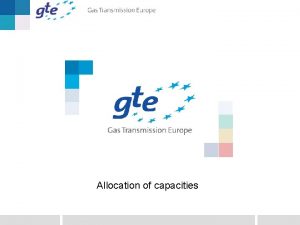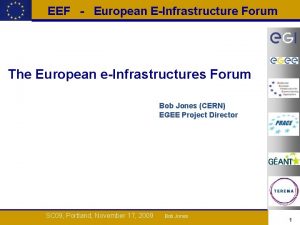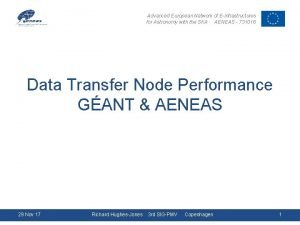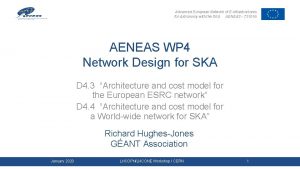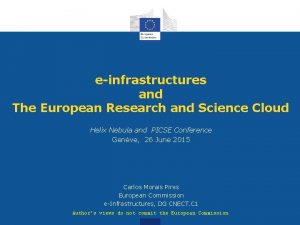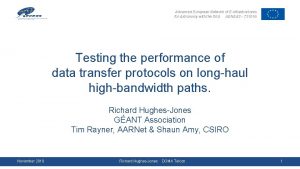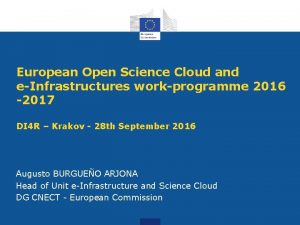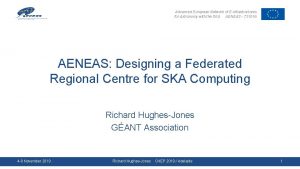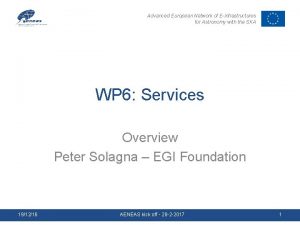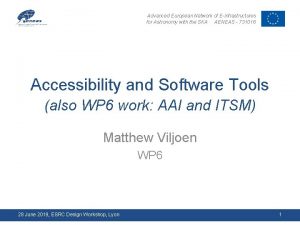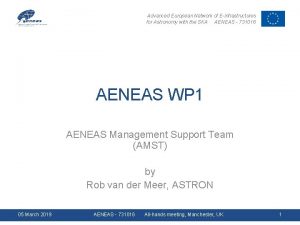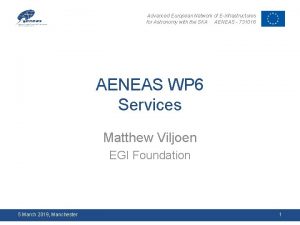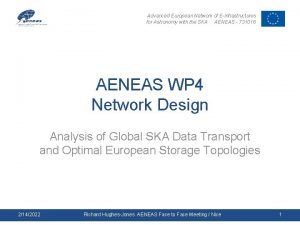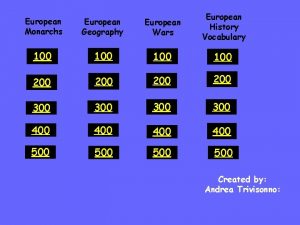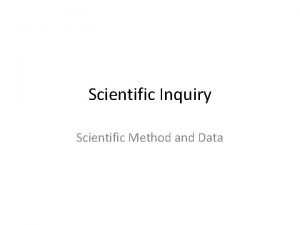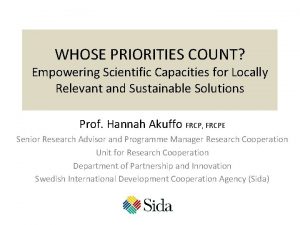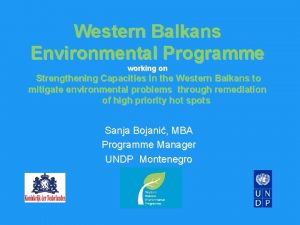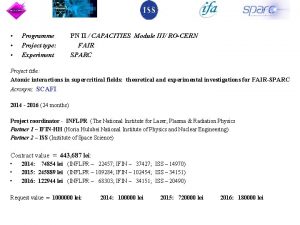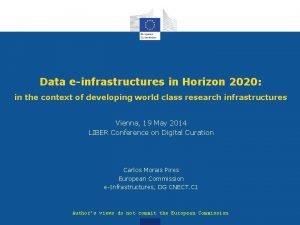Scientific Data eInfrastructures in the European Capacities Programme
























- Slides: 24

Scientific Data e-Infrastructures in the European Capacities Programme PV 2009 1 December 2009, Madrid Krystyna Marek European Commission "The views expressed in this presentation are those of the author and do not necessarily reflect the views of the European Commission"

The ‘map of science’ Journal Nature (Dec 2006): This map was constructed by sorting roughly 800, 000 published papers into 776 different scientific paradigms (shown as pale circular nodes) based on how often the papers were cited together by authors of other papers. […]

e-Science Cross-disciplinary, cross-border… New problems, new science … From wet-labs to virtual labs … Data-centric science, information flood… Science is changing ICT and ICT is changing Science

e-Infrastructures for science environments where research resources can be readily shared and accessed Sharing and federating scientific data Sharing computers, instruments and applications Linking at the speed of the light. . . . Scientific facilities

Fostering Global Virtual Research Communities Scientific Communities e-Infrastructures • • • • Geographically spread Culture heterogeneity Problem Complexity Volumes of information Quality of information Incentives to share Organisational barriers Connectivity Collaboration Processing, Simulation Repositories of data Curation/Review Trust Knowledge advantage

What can we do for Science… To facilitate a rapid transition to e-Science, the European Commission and Member States have made significant investments in e. Infrastructures… Innovating the scientific process: global virtual research communities Linking the ideas at the speed of the light: GÉANT Sharing the best computational resources: e-Science grid, supercomputing Accessing knowledge: scientific data Designing future facilities: novel e-Infrastructures

ICT infrastructures for e-Science: a Communication to European Institutions COM(2009) 108 Highlighting the importance of embracing the e. Science paradigm shift. Highlighting the strategic role of e-Infrastructures as a crucial asset underpinning European research and innovation policies. Calling on Member States and the scientific communities, in cooperation with the EC for a reinforced and coordinated effort to further develop world class e-Infrastructures.

ICT infrastructures for e-Science: renewed strategy COM(2009) 108 e-Science Europe global partner Innovation Excellence/Knowledge exploiting know-how even beyond science i at on n i rd o i Co / y lit b na s i ta Su e-Infrastructure providing 24/7 services Organisational Models/Governance

On Scientific Information in the Digital Age: Access, Dissemination and Preservation COM(2007) 56 "The Internet […] opened new ways to use masses of data resulting from experiments and observations in the scientific process and to extract meaning from this data stored in repositories in combination with other scientific information resources. This leads to a 'continuum' of scientific information space from raw data to publications across different communities and countries". In the Communication "On Scientific Information in the Digital Age (…)“ the EC has pointed out that building in Europe a dynamic information society requires providing wide access and ensuring long term preservation of scientific information.

Orchestration within the e-Infrastructure: need for coordinating all elements and layers Information e-Infrastructure of repositories Repository services Management of Repositories Management of Access e-Infrastructure for repositories Processing, Computation Physical infrastructure Adapted from e-Sci. DR study

Scientific Data Infrastructure scientific data infrastructure distributed computing/software infrastructure network infrastructure, GÉANT

First SDI calls in FP 7 INFRA-2007 -1. 2. 1: Scientific Digital Repositories EU funding = 15 Million Euro INFRA-2007 -1. 2. 2: Deployment of e -Infrastructures for Scientific Communities INFRA-2007 -3. 3: Studies, conferences and coordination actions supporting policy development INFRA-2008 -1. 2. 2: Scientific Data Infrastructure EU funding = 20 Million Euro

European Virtual Observatory With Euro. VO-AIDA we have learnt how concept of a “Virtual Observatory” embraces the paradigm shift in science to cope with the progress of astronomical discoveries VOs enable making new science by developing a federated repository of astronomical data conforming to globally agreed access protocol standards VOs boost the research potential in astronomy, increase its efficiency and democratise access to astronomic data

e-infrastructure for OA pilot FP 7 Open Access pilot follows the Conclusions of the EU Competitiveness Council of 22 and 23 November 2007 Its key objective is to enable fast and reliable access to EU-funded research results, in particular peer reviewed research articles Projects from 7 areas of FP 7 are required to deposit articles and make their best effort to ensure OA Open. AIRE project was selected in an open call to provide an e-infrastructure supporting mechanisms for the identification, deposit, access, and monitoring of articles

Recent call for Proposals Published: 30/07/2009 - Closed: 24/11/2009 15

e-Sci. DR study recommendations Build an e-Infrastructure which ensures “research continuity” Funding, Governance and management, leverage on other e-Infrastructure layers Engage users and service providers Support for data producers, Trust and recognition, Training and awareness Provide access to researchers, educators and students Discovery and navigation, OA to publicly funded data, International collaborations Maintain and preserve information Collections management, selection and appraisal for sustainability source: e. Sci. DR study (adapted)

Scientific Data - Looking ahead “Big, complex data-intensive science" of global dimension is here to stay; hence the increasing value of observational and experimental data in virtually all fields of science. We need to exploit the growing sensor/effector layer to make the world itself a real-time database. (from the creativity machine, V. Vinge) Europe pays particular attention to the aspects of accessibility to scientific information, its quality assurance and preservation. Multi-disciplinary approaches, new participative paradigms and global research communities are an essential part and driver of the strategy. …but organisational, governance and financing models need further attention, taking into account sociological, political and cultural considerations.

For further information www. cordis. europa. eu/fp 7/ict/e-infrastructure/

Annex: SDI Projects

SDI – call 1 projects Digital repository for cosmic ray data, pooling archives and collecting observations real-time. Improving protein annotation through coordination and integration of databases Common Information Model and tools for using climate data and models

SDI – call 1 projects Moves the astronomical European Virtual Observatory into a fully functioning operational phase. Open and seamless access to Earth science repositories (space, airborne and in-situ sensors data) Flexible, robust, scalable and cohesive pan-European infrastructure of Digital Repositories

SDI – call 1 & 2 projects Virtual research environment for Environmental Monitoring and Fishery Resource Management. Taxonomically validated standardised nomenclatures for biological and biodiversity management. Long-term preservation, permanent access to digital resources (intellectual capital of Europe).

SDI – call 4 projects Reengineering the 'Catalog of Life' (Co. L), leading infrastructure in the field of taxonomy of living organisms Works towards making the access to atomic and molecular data simpler and more integrated Deploys services for heliophysics researchers, exploring the sun-solar system connection

SDI – call 4 projects Enables interoperability of data einfrastructures in biodiversity, fisheries and high energy physics Access to marine geological and geophysical data from national geological surveys and research institutes Provides an infrastructure to allow the remote evaluation of semantic technologies
 Epp program
Epp program Co-funded by the erasmus+ programme of the european union
Co-funded by the erasmus+ programme of the european union Co-funded by the erasmus+ programme of the european union
Co-funded by the erasmus+ programme of the european union Co-funded by the erasmus+ programme of the european union
Co-funded by the erasmus+ programme of the european union Cfe 4 capacities
Cfe 4 capacities Demands and capacities model
Demands and capacities model Four capacities
Four capacities Describe capacities newborns display
Describe capacities newborns display Perceptual capacities
Perceptual capacities Protective capacities
Protective capacities Electron shell capacities
Electron shell capacities Latent heat of lead
Latent heat of lead Bronchial tree
Bronchial tree Information gathered during an experiment
Information gathered during an experiment How is a scientific law different from a scientific theory?
How is a scientific law different from a scientific theory? Building safety programme monthly data release
Building safety programme monthly data release Hình ảnh bộ gõ cơ thể búng tay
Hình ảnh bộ gõ cơ thể búng tay Slidetodoc
Slidetodoc Bổ thể
Bổ thể Tỉ lệ cơ thể trẻ em
Tỉ lệ cơ thể trẻ em Chó sói
Chó sói Thang điểm glasgow
Thang điểm glasgow Alleluia hat len nguoi oi
Alleluia hat len nguoi oi Các môn thể thao bắt đầu bằng tiếng chạy
Các môn thể thao bắt đầu bằng tiếng chạy Thế nào là hệ số cao nhất
Thế nào là hệ số cao nhất
